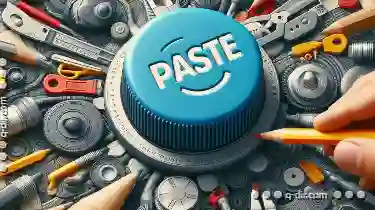This seemingly simple action-copying content from one location and pasting it into another-is a staple of daily computing tasks. However, what many users ...
 might not realize is that how they interact with this feature can significantly influence their approach to creativity and originality. Let's delve deeper into the nuanced role of the "paste" button in shaping our file management habits and explore whether it leans more towards being a friend or foe when it comes to fostering originality. In the digital age, where file management and organization have become increasingly crucial for productivity, the humble "paste" button often finds itself in the limelight.
might not realize is that how they interact with this feature can significantly influence their approach to creativity and originality. Let's delve deeper into the nuanced role of the "paste" button in shaping our file management habits and explore whether it leans more towards being a friend or foe when it comes to fostering originality. In the digital age, where file management and organization have become increasingly crucial for productivity, the humble "paste" button often finds itself in the limelight.1. Understanding the Basics: Copying vs. Pasting
2. The Role of the "Paste" Button in File Management
3. Pasting vs. Rewriting: The Dilemma
4. The Impact of Pasting on Creativity
5. Enhancing Originality Through Smart Use
6. Conclusion: Finding the Middle Ground
1.) Understanding the Basics: Copying vs. Pasting
First, let’s clarify what we mean by copying and pasting files and folders. When you copy content (like text, images, or entire documents), you are essentially creating an exact duplicate of that item on your device. This is done using a software tool like Ctrl+C (Windows) or Command+C (Mac) for copying. Once copied, the content can be pasted to another location using either Ctrl+V (Windows) or Command+V (Mac).
2.) The Role of the "Paste" Button in File Management
The primary role of the paste function is undoubtedly to facilitate quick and easy transfer of files from one place to another. This not only saves time but also ensures that modifications made to the original file do not affect its duplicated version, thus preserving integrity and ensuring that edits can be applied without losing any data. However, as we will explore next, this convenience could potentially have unintended consequences on creativity and originality.
3.) Pasting vs. Rewriting: The Dilemma
One of the most significant debates around using the paste function revolves around whether it encourages rewriting or simply repurposing content. When you copy text from a book and paste it into an essay, for example, you are essentially taking someone else's ideas (or words) and incorporating them into your work. This can be both beneficial and detrimental:
- Beneficial: Pasting allows users to reference existing information without having to rediscover or recreate the wheel. It is a quick way to integrate relevant data that supports an argument, analysis, or creative expression.
- Detrimental: Overreliance on paste can lead to plagiarism if not properly cited, and it can stifle originality by providing ready-made solutions that remove the need for independent thinking and creation.
4.) The Impact of Pasting on Creativity
Creativity often thrives in environments where there is room for exploration, experimentation, and unique perspectives. When using a paste function, users might inadvertently adopt someone else's style or approach, which can limit their own creative expression:
- Inspiration vs. Imitation: The key to effective creativity lies in the balance between inspiration (taking ideas from others) and originality (developing your own unique perspective). Pasting content too freely can tip the scale towards imitation, as users might subconsciously adopt others' styles without realizing it.
- Encouraging Versatility: On a more positive note, using paste to repurpose information could encourage versatility in thought processes, allowing for the combination of different ideas into novel outputs. This is particularly useful for fields like research and academic writing where novelty combined with referencing can lead to groundbreaking insights.
5.) Enhancing Originality Through Smart Use
To make sure that the "paste" button does not hinder originality but rather enriches it, consider adopting these strategies:
- Cite Properly: Always cite your sources when using paste. This not only protects you from plagiarism but also gives credit where it's due and allows others to trace back to the original information if needed.
- Modify and Adapt: After pasting content, rewrite or rephrase it in your own words. This process forces a deeper engagement with the material and encourages critical thinking about what is being absorbed and how it can be expressed differently.
- Use as a Starting Point: Instead of using paste to copy entire documents, use it as a starting point to generate new ideas or formats that are uniquely yours. This approach not only promotes originality but also challenges users to think more flexibly about their content creation.
6.) Conclusion: Finding the Middle Ground
In conclusion, while the "paste" button is undeniably useful for efficient file management, its overuse can undermine creativity and originality. By understanding how to use it effectively-by citing sources appropriately, modifying content, and using it as a springboard rather than a straightjacket-users can harness both its convenience and its potential to enhance their creative output. Thus, the "paste" button need not be an adversary of originality; instead, with wise usage, it can become a valuable ally in expanding our ideas and perspectives.

The Autor: / 0 2025-04-02
Read also!
Page-

Address Bar: A Dead End for Modern Discovery Engines?
However, beneath its seemingly outdated facade lies a wealth of potential that modern discovery engines are just beginning to tap into. Let's explore ...read more

Why ‘Copy’ Doesn’t Always Mean ‘Backup’ (And Why That’s Dangerous)
However, many users often misinterpret what copying a file or folder truly means-and this can lead to significant risks if not properly understood. ...read more

The Tyranny of the Default View: Why Explorer Still Fails Us.
Among these, File Explorer, also known as Windows Explorer on Windows systems, has been a staple in managing files and directories since the early ...read more